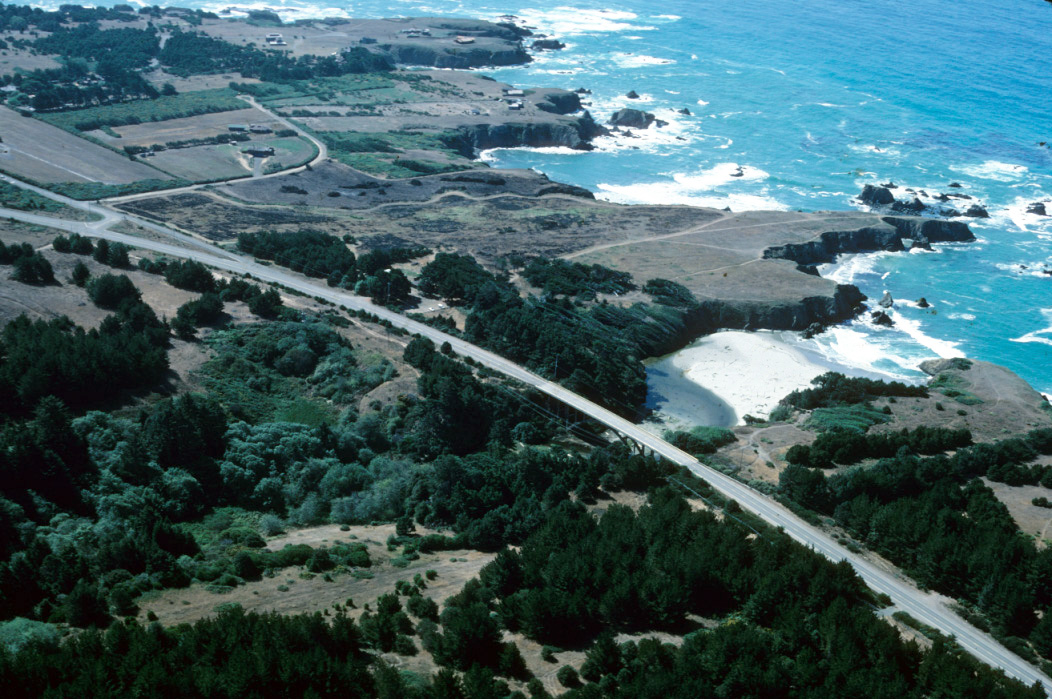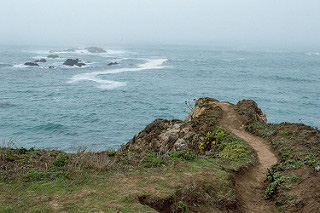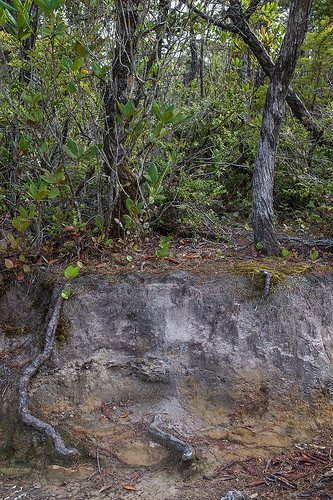SCIENCE AND NATURE
WILDLIFE
Sea lions sun themselves on the rocks, and migrating gray whales can be spotted off the Mendocino coast from mid-December to early April. Black oystercatchers and other shorebirds forage on the beach while gulls, hawks, and American kestrels fly overhead. Coho salmon and steelhead make their home in the creek. Nature-lovers will often hear the rat-a-tat of hairy woodpeckers punctuating the silence of the quiet woods. A variety of wildlife can be found on the different steps of the ecological staircase ranging from gray foxes, badgers, and coyotes to California quail, northern harriers, and pygmy owls. Black bears live in the area but are rarely seen in the park.
ECOLOGY OF THE ECOLOGICAL STAIRCASE

Five elevated marine terraces along Jug Handle Creek form an ecological staircase of ancient wave-cut steps formed by the movement of the Pacific Ocean, continental glaciers, and tectonic plates. Beginning more than half a million years ago during the Pleistocene Epoch (11,000–1.1 million years ago) when the glaciers retreated, sea level rose more rapidly than the land. As the pounding waves rose onto the land, they shaped an underwater terrace honed by cobbles rubbing against bedrock. Over time, the North American tectonic plate pushing against the Pacific plate elevated the terrace. When glaciers advanced, the waves slowly receded as the sea level fell, and deposits of gravel and sand were spread across the emerging terrace by the retreating waves. As time passed, new terraces were created where older ones once existed.
Each terrace was uplifted from sea level about 100,000 years before the one below. The terraces continue their rise at the rate of an inch per century.
Only the first two terraces are in Jug Handle State Natural Reserve. The third, fourth and fifth terraces are in Jackson Demonstration State Forest.
FIRST TERRACE
The youngest, lowest terrace is a broad, flat bluff of coastal prairie overlooking the ocean. This terrace is blanketed with many non-native grasses such as hairgrass and velvet grass, the result of past livestock grazing. Visitors may spot black-tailed deer munching on native Pacific reed grasses while meadowlarks fly overhead. Pocket gophers burrow beneath Mendocino paint brush, California poppies, and other native wildflowers that bloom each spring and summer.
SECOND TERRACE
Inland and upward on the second terrace, a shady mixed forest of coast redwoods, Douglas-fir, and rare Northern Bishop pine envelopes visitors. Gorgeous pink rhododendrons cluster on the ends of branches, and vivid green sword fern, redwood sorrel, and thimbleberry carpet the woodland area. Banana slugs inch along the forest floor, and yellow-bellied sapsuckers and other woodpeckers drum in the trees above.
THIRD TERRACE
Unique pygmy forests of bonsai-like trees are found on the next three terraces. The third terrace features Bolander pine, dwarf manzanita, and pygmy cypress. In this tangle of tiny trees and shrubs, including the aromatic Labrador tea, hikers may glimpse black-tailed jackrabbits and, occasionally, bobcats.
FOURTH TERRACE
Snakes and salamanders slither through California sedge while wrentits trill overhead and deer mice dart among the wax myrtle and Fort Bragg manzanita. Colorful coast lilies and swamp harebells are also found on this mossy terrace.
FIFTH TERRACE
More than 500,000 years old, this terrace is 650 feet above sea level. Centuries of rain have leached the soil, causing decades-old cypresses and Bolander pines to stop growing at two-and-a-half-feet tall. Pygmy nuthatches flitter and common nighthawks roam the night skies.
GEOLOGY
The terraces of the Ecological Staircase are made of graywacke sandstone that has been weathered for different lengths of time. The soils on the upper staircases are among the oldest in the world. The reason for their antiquity is horizontal uplift; it is very unusual to have uplift without tilting over geological periods of time.
The terraces were formed by fluctuations in sea level as continental glaciers melted and by movement of the earth's crust (plate tectonics). These two factors are massive agents in the shaping of land forms and are rarely seen so clearly outside the desert regions of the world.
The principal sculptor at Jug Handle is the sea. During periods in the Pleistocene Epoch, when glaciers were retreating northward, the sea level rose more rapidly than the motion of tectonic plates boosting the land. As the pounding waves came up onto the land, they fashioned a smooth terrace. With the renewal of glaciation, the waves slowly receded as the sea level fell.
Deposits of beach material (gravel and sand) were spread across the emerging terrace by the retreating waves. Continued uplifting of the land raised the terrace clear of subsequent rises in sea level. In this fashion, new terraces were created. Terrace number five (the oldest) was once at the elevation now occupied by number four, and so on.
New terraces formed at intervals of about 100,000 years and involved about 100 feet of uplift. The higher the terrace, the older it is, and the longer its beach materials have been weathering.
Another active agent forming the land at Jug Handle is the wind. Coastal breezes have been depositing beach material on the first terrace where the bluffs are low. Similarly, the seaward edge of each terrace was covered with ancient gravel and sand in the past.
PLANT COMMUNITIES
COASTAL PRAIRIE
Most of the common grasses that dominate the reserve’s first terrace are non-native species introduced by farming and grazing by early settlers. The fibrous roots of these grasses have created a rich soil by adding humus through the annual cycle of root growth and death. During the spring and summer months, colorful displays of native wildflowers also dot the coastal prairie. Among the most common species are orange and yellow California poppies, pink sea thrift, white yarrow, and baby blue eyes.
NORTH COAST BLUFF SCRUB

The North Coast Bluff Scrub community found along the edge of the cliff is made up of perennial low-growing shrubs like purple and yellow seaside daisy (Erigeron glaucus), yellow flowered sticky gum plant (Grindelia stricta), and nitrogen-fixing bluff lupine (Lupinus littoralis). These plants can endure strong winds and salt spray from the ocean because they grow low to the ground. Tiny hairs also protect them from drying winds. The coastal prairie grows along the margin of the bluff community
BISHOP or CLOSED-CONE PINE FOREST
Unlike most conifers, Bishop pine (Pinus muricata) does not open its cones and distribute its seeds when they are mature. Instead, it releases its seeds only when its cones are exposed to intense heat. This adaptation to fire discharges seeds into a bed of fertile ash. Bishop pine grows to less than a hundred feet tall and lives only up to about 80 years. It has deeply furrowed bark and two needles to a bundle. At Jug Handle, it grows on sandy soils on the first terrace near the ocean, on old dunes in patches in the redwood forests, and in older soils in the pygmy forest.
SITKA SPRUCE/GRAND FIR FOREST
Jug Handle’s second terrace is dominated by Sitka spruce and grand fir. This plant community is part of the great Pacific Northwest forest that ranges close to the coast from southern Alaska south to Mendocino County. Other species that commonly occur in this forest are western hemlock, Douglas fir, salal, sword fern, and blue huckleberry. Sitka spruce bark is scaly; grand fir bark is flatter. Jug Handle Creek is the southernmost edge of the Sitka spruce range.
REDWOOD FOREST
Reaching heights of over 350 feet, coast redwoods (Sequoia sempervirens) are the tallest trees in the world. They have a limited distribution, occurring only along the coast, between southern Oregon and central California where summer fog and moderate temperatures prevail. The bark is thick, red, fibrous, and fire resistant. Needles fall to the ground in branchlets instead of singly, as in other conifers. The heartwood is red and the sapwood is pink. The small oval cone is about 1 inch in diameter with its scales touching like in a soccer ball instead of overlapping like in the cones of pines, firs, and spruces. The heartwood, especially in old-growth, is rot resistant.
Redwoods grow a short distance away from the salt-laden breezes of the ocean on slopes, flood plains, and level sea-cut terraces. They create their own environment. Their needles collect moisture from summer fog. Tall groves, especially of old-growth trees, create deep shade. Some birds, insects, mammals, and amphibians live high in the canopy, where they can find the most light and food. Certain lichens found in the canopy transform nitrogen molecules essential for the plants and animals of the redwood forest.
RIPARIAN
The “riparian” trees and shrubs that grow beside rivers and streams include willows (Salix lasiandra), red alder (Alnus rubra), and cascara (Frangula purshiana). These plants require more moisture than plants growing farther away. They provide shade for the waterway in spring and summer. Because most of them lose their leaves in the fall, they let in light and warmth in winter. This keeps the water temperature at levels that provide optimal conditions for fish such as Coho salmon and steelhead trout.
PYGMY FOREST

Pygmy forests occur only in a few sites along the California coast where sea-cut terraces and their soil surfaces have remained flat during half a million years of geological uplift. The trees and shrubs are stunted by an extremely nutrient-poor, highly acidic soil underlain by an iron hardpan. Soils here are 1,000 times more acidic than soil in the redwood forest. Heavy winter rains have leached iron and other soil nutrients down to the subsoil (eroding bedrock). The iron, soluble under acidic conditions, combines with the subsoil to form 18 inches of concrete hardpan. So, the forest becomes like a bog. The soil never dries out beneath the surface. Once water has replaced air in the pores of the soil, it’s hard for plant roots to get the oxygen they need.
The result of all these forces is the stunted, sparse growth of the pygmy forest. After leaching for hundreds of thousands of years, the soil is white. One-hundred-year-old trees are only a few feet high. The needles of stunted redwoods turn yellow—lacking in nutrients. In places where these moist coastal environments are undisturbed, a fragile lichen crust covers the ground and trees.
Rhododendron, huckleberry, and salal are common in both the redwood and pygmy forests, but they are smaller when growing in pygmy soil. The pygmy cypress, Bolander pine, and Fort Bragg manzanita tend to be more restricted to the pygmy forest due to their inability to compete well with other species.
The State Natural Reserve's Ecological Staircase Trail ends on Jug Handle’s third terrace at the park boundary. The pygmy forest community extends further eastward into Jackson Demonstration State Forest. Trail guides on the ecology, history, and management of the Jackson Forest are available online.
